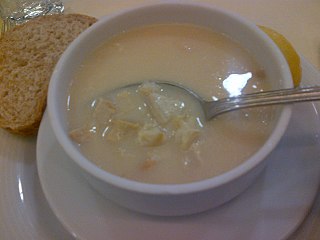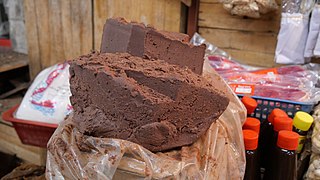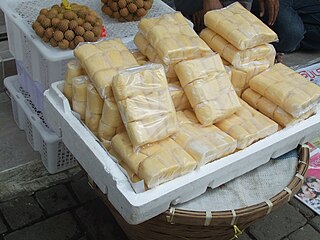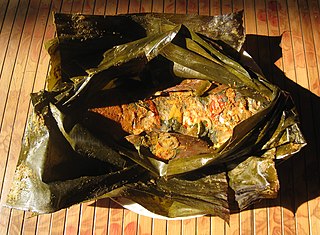Related Research Articles

Garum is a fermented fish sauce that was used as a condiment in the cuisines of Phoenicia, ancient Greece, Rome, Carthage and later Byzantium. Liquamen is a similar preparation, and at times they were synonymous. Although garum enjoyed its greatest popularity in the Western Mediterranean and the Roman world, it was earlier used by the Greeks.

Idli or idly is a type of savoury rice cake, originating from South India, popular as a breakfast food in Southern India and in Sri Lanka. The cakes are made by steaming a batter consisting of fermented black lentils (de-husked) and rice. The fermentation process breaks down the starches so that they are more readily metabolised by the body.

Bagoóng is a Philippine condiment partially or completely made of either fermented fish (bagoóng) or krill or shrimp paste (alamáng) with salt. The fermentation process also produces fish sauce known as patís.

Tripe soup or tripe stew is a soup or stew made with tripe. It is widely considered to be a hangover remedy.

Gravlax or graved salmon is a Nordic dish consisting of salmon that is cured using a mix of salt and sugar, and either dill or sprucetwigs placed on top, and may occasionally be cold-smoked afterwards. Gravlax is usually served as an appetizer, sliced thinly and accompanied by hovmästarsås, dill and mustard sauce, either on bread or with boiled potatoes.

Shrimp paste or prawn sauce is a fermented condiment commonly used in Southeast Asian and Southern Chinese cuisines. It is primarily made from finely crushed shrimp or krill mixed with salt, and then fermented for several weeks. They are either sold in their wet form or are sun-dried and either cut into rectangular blocks or sold in bulk. It is an essential ingredient in many curries, sauces and sambal. Shrimp paste can be found in many meals in Cambodia, Indonesia, Laos, Malaysia, Myanmar, the Philippines, Singapore, Thailand, and Vietnam. It is often an ingredient in dip for fish or vegetables.

Noodle soup refers to a variety of soups with noodles and other ingredients served in a light broth. Noodle soup is a common dish across East Asia, Southeast Asia and the Himalayan states of South Asia. Various types of noodles are used, such as rice noodles, wheat noodles and egg noodles.

Appam (Malayalam:അപ്പം) or āppa is a type of thin pancake originating from South India and Sri Lanka. It is made with fermented rice batter and coconut milk, traditionally cooked in an appachatti, a deep pan similar in shape to a wok. It is part of Kerala and Tamil cuisine found in the Indian states of Kerala, Tamil Nadu and Sri Lanka. Appam are most frequently served for breakfast or dinner, often with a topping such as an egg.

Peranakan cuisine or Nyonya cuisine comes from the Peranakans, descendants of early Chinese migrants who settled in Penang, Malacca, Singapore and Indonesia, inter-marrying with local Malays. In Baba Malay, a female Peranakan is known as a nonya, and a male Peranakan is known as a baba. The cuisine combines Chinese, Malay, Javanese, South Indian, and other influences.

Tapai is a traditional fermented preparation of rice or other starchy foods, and is found throughout much of Southeast Asia, especially in Austronesian cultures, and parts of East Asia. It refers to both the alcoholic paste and the alcoholic beverage derived from it. It has a sweet or sour taste and can be eaten as is, as ingredients for traditional recipes, or fermented further to make rice wine. Tapai is traditionally made with white rice or glutinous rice, but can also be made from a variety of carbohydrate sources, including cassava and potatoes. Fermentation is performed by a variety of moulds including Aspergillus oryzae, Rhizopus oryzae, Amylomyces rouxii or Mucor species, and yeasts including Saccharomyces cerevisiae, and Saccharomycopsis fibuliger, Endomycopsis burtonii and others, along with bacteria.

Pepes is an Indonesian cooking method using banana leaves as food wrappings. The banana-leaf package containing food is secured with lidi seumat, and then steamed or grilled on charcoal. This cooking technique allows the rich spice mixture to be compressed against the main ingredients inside the individual banana-leaf package while being cooked, and also adds a distinct aroma of cooked or burned banana leaf. Although being cooked simultaneously with food, the banana leaf is a non-edible material and is discarded after consuming the food.

Ngapi, formerly also spelled ngapee, nga-pee and gnapee, is a pungent paste made of either fish or shrimp in Burmese cuisine. Ngapi is usually made by fermenting fish or shrimp that is salted and ground then sundried. Like cheese, it can be distinguished based on main ingredient and regional origin. Ngapi can be distinguished by the type of fish used to make it. Ngapi can come from whole fish, from small fish or from prawns. Ngapi is a main ingredient of Lower Burmese cooking and is used as a condiment or additive in most dishes. Raw ngapi, with some exceptions, is not intended for direct consumption.

Shark meat is a seafood consisting of the flesh of sharks. Several sharks are fished for human consumption, such as porbeagles, shortfin mako shark, requiem shark, and thresher shark, among others. Shark meat is popular in Asia, where it is often consumed dried, smoked, or salted. Shark meat is consumed regularly in Iceland, Japan, Australia, parts of India, parts of Canada, Sri Lanka, areas of Africa, Mexico and Yemen.

Pekasam, Pakasam or Bekasam is a Malay term for fermented food, more precisely fermented fish product. In Malay and Banjar cookery, pekasam usually refers to freshwater fish fermented with salt, palm sugar, toasted rice grains and pieces of asam gelugur.
Dayok is a Philippine condiment originating from the islands of Visayas and Mindanao in the Philippines. It is made from fish entrails, excluding the heart and the bile sac. It is fermented with salt, and sometimes rice wine (pangasi) and various herbs. It has a sharp umami and salty flavor very similar to patis and bagoong. They are sold in sealed glass bottles.
References
- 1 2 Lee CH, Steinkraus KH, Reilly PJA. 1993. Fish Fermentation Technology. Tokyo: United Nations University.
- ↑ Irianto, Prof Dr Ir Hari Eko. Produk Fermentasi Ikan (in Indonesian). Penebar Swadaya Grup. p. 86. ISBN 978-979-002-575-2.
- ↑ Matsuyama (2013-11-05). Traditional Dietary Culture Of S. Routledge. p. 360. ISBN 978-1-136-88794-9.
